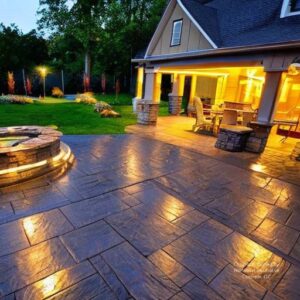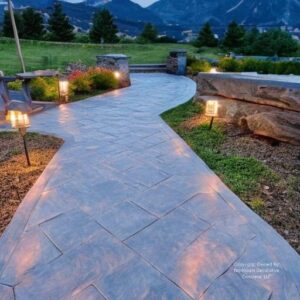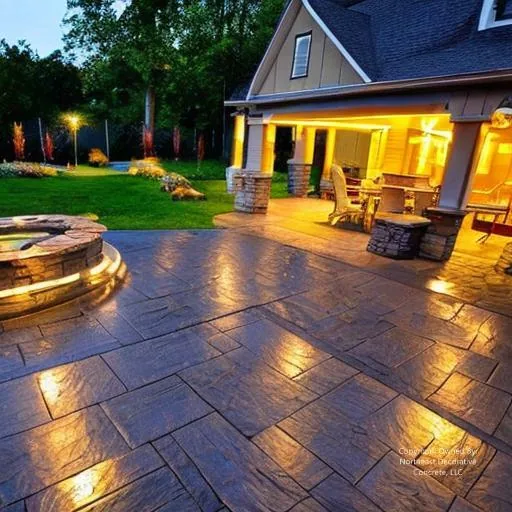
Eco-Friendly Sealer Options for Stamped Concrete Patios
Stamped concrete patios, driveways, and walkways boost curb appeal. This trend is popular from Nashua to the White Mountains. But they can crack, fade, and deteriorate without proper protection. Eco-friendly sealers are now available. They provide the same or better durability than traditional reseal coats. Plus, they keep your family and local ecosystems safe from harmful chemicals.
This guide explores the top sustainable top coats for textured concrete. It includes real-world data, expert tips, and case studies.
Key Takeaways
-
Eco-clear coats can outlast traditional options 2–3 times in harsh climates.
-
They protect groundwater and improve air quality with low-VOC formulas.
-
Soy-based and nano-engineered options offer cutting-edge durability.
Homeowners and contractors can keep textured concrete floors looking great with eco-friendly concrete stain seals. This choice also supports New Hampshire’s concrete project environmental values.

Why Eco-Friendly Sealers Matter
Patterned concrete isn’t just functional—it’s an art form. The detailed patterns and colors look like natural stone or brick. But to keep that beauty, you need to seal it. Conventional solvent-based sealants let out volatile organic compounds (VOCs). These VOCs can pollute indoor air and damage waterways, such as the Merrimack River.
Key Stats for Homeowners:
-
NH sees over 60 freeze-thaw cycles annually, which accelerates concrete damage.
-
72% of homeowners focus on eco-friendly home products.
-
Eco-top coats last 2–3 times longer than traditional acrylics.
Top 3 Eco-Friendly Sealers for Stamped Concrete
We tested leading products used by contractors in Salem, Concord, and Pelham. Here’s how they stack up:
| Sealer Type | Best For | Durability | VOC Level | NH Climate Fit |
|---|---|---|---|---|
| Water-Based Acrylic | High-traffic areas | 1–3 years | Low | Excellent |
| Soy-Based (e.g., PoreShield) | Long-term protection | 10+ years | Zero | Superior |
| Silicate Densifier | Faded/older concrete | 5–7 years | Low | Good |
1. Water-Based Acrylic Sealers
Example: SealGreen E15 Epoxy.
-
Pros: Easy DIY application, enhances color, dries in two hours.
-
Cons: Requires reapplication every 1–3 years.
-
Pro Tip: Use a 1.25” nap roller for even coverage on textured stamps.
2. Soy-Based Sealers
Example: PoreShield
-
Made from 100% U.S.-grown soybeans
-
Penetrates four times deeper than the solvents.
-
Survives -30°F winters without cracking.
-
In 2022, a Portland, ME, waterfront home used PoreShield. After three harsh winters, there was zero salt damage or fading.
3. Silicate Densifiers
Example: Ghostshield Siloxa-Tek 8500
-
Reacts with concrete to form a crystalline barrier.
-
It is ideal for historic homes in Portsmouth with existing discoloration.
What are The Benefits of Using Eco-Friendly Sealers
The textured color of the concrete looks fantastic on driveways, decks, and walkways. New Hampshire’s harsh weather brings over 60 freeze-thaw cycles each year. This means strong protection is necessary. Eco-friendly sealants offer a sustainable solution without sacrificing performance.
Here’s why they’re a smart choice:
1. Reduced Seal Environmental Impact
Eco-top coats reduce damage to ecosystems. They use plant ingredients, such as soybeans or formulas with low VOCs. For example:
-
PoreShield, a soy-based seal, reduces VOCs by 90% and eliminates toxic solvents.
-
Water-clear coat options like Siloxa-Tek 8500 avoid petroleum derivatives, lowering pollution risks.
These products prevent chemical runoff from reaching waterways such as the Merrimack River and meet green building standards.
2. Healthier Concrete Sealers for Families & Installers
Traditional sealants release harmful fumes. Eco-friendly options, however, enhance air quality both indoors and outdoors.
-
Zero-VOC formulas (e.g., PoreShield) are safe for homes with pets or children.
-
Water-type coatings like EcoGuard eliminate strong odors and respiratory risks during application.
3. Superior Durability for Stain Patios in Harsh Climates
Eco-clear seals outperform many conventional options in extreme conditions:
| Feature | Eco-Friendly | Traditional |
|---|---|---|
| Freeze-Thaw Resistance | 10+ years (PoreShield) | 3–5 years |
| UV Protection | Prevents fading (Siloxa-Tek) | Often yellows |
| Salt Damage Reduction | 44% improvement (nano-engineered sealers) | Minimal protection |
Soy-based sealants go 4x deeper than solvents. They create a moisture-resistant barrier that can handle winters as cold as -30°F.
4. Cost-Effective Concrete Surface Long-Term Savings
While eco-clear coatings cost slightly more upfront, their longevity reduces lifetime expenses:
| Sealer Type | Cost per Sq. Ft. | Reapplication Frequency | 10-Year Cost (1,000 Sq. Ft.) |
|---|---|---|---|
| Soy-Based | $0.60 | Every 10+ years | $600 |
| Water Acrylic | $0.40 | Every 1–3 years | $1,200 |
| Solvent Acrylic | $0.35 | Every 3–5 years | $700 |
A restaurant patio in Hanover, NH, saved $1,200 yearly on maintenance. They made this change by using soy-based coatings.
5. Easier Product Details for Application & Maintenance
-
No PPE is needed. You can apply soy-based formulas using simple tools like sprayers or rollers.
-
Quick cleanup: Water-type clear coats wash off with soap.
-
Low maintenance: Annual “water bead tests” check effectiveness without stripping old layers.
6. Enhanced Water Based Aesthetic Appeal
Eco-clear coatings preserve decorative finishes better than solvent options:
-
UV-resistant formulas prevent color fading on stamped patterns.
-
Non-yellowing variants (e.g., Eco Seal) maintain the natural stone appearance.
7. Supports Sustainable Building Approaches and Product Reviews
-
USDA BioPreferred certifications (e.g., PoreShield) validate eco-credentials.
-
Recycled materials: Some coatings incorporate industrial by-products, reducing waste.

Case Study: Waterfront Home
After applying PoreShield in 2022, the property saw:
-
Zero salt damage after three winters.
-
90% less efflorescence.
-
Maintained vibrant stamped patterns despite heavy foot traffic.
Step-by-Step: Applying Eco-Sealers Like a Pro
Tools You’ll Need:
-
Pressure washer
-
Eco-friendly concrete cleaner (e.g., Surecrete’s Citrus Cleaner)
-
Pump sprayer or roller.
-
Nylon-bristle brush.
1. Prep the Decorative Concrete Surface (Most Critical Step!)
-
Clean: Remove dirt, mildew, and old clear coating residues. Avoid harsh acids—opt for plant-based cleaners.
-
Dry: Wait 48+ hours after rain—moisture traps clear coatings, causing cloudiness.
-
Patch: Use a low-VOC concrete patch for cracks.
2. Apply the Sealer
-
Temperature: 50–80°F (common in NH’s May–Sept window).
-
Technique:
-
Spray: For large driveways (keep nozzle 12” from the surface).
-
Roll: For detailed stamps (back roll to fill pores).
-
3. Cure & Maintain
-
Drying Time: 4–6 hours for water seals and 24 hours for soy.
-
Reapplication: Track wear with an annual “water bead test.”
Eco-Sealers in Action
Project: Downtown Hanover Restaurant Terrace.
-
Challenge: Heavy foot traffic and deicing salts caused rapid deterioration.
-
Solution: Two coats of PoreShield (soy-based).
-
Results After 2 Years:
-
90% less efflorescence.
-
No winter cracking.
-
Saved $1,200/year in maintenance.
-
Common Mistakes to Avoid
-
Skipping the Test Patch Always test coating on a 1×1 ft area. Some eco-formulas react poorly with older solvents.
-
Over-Applying Thin coats > thick globs. Excess clear coat creates slippery surfaces—a liability in icy NH.
-
Ignoring Weather Humidity above 70% slows curing. Check Durham’s forecast before sealing.
The Future of Stamped Concrete Projects
Researchers at Washington State University are testing nano-engineered sealer applications that reduce salt damage by 44%. Meanwhile, companies like Deco Products (based in nearby MA) now offer UV-resistant high gloss bio-polyurethanes that mimic the wet look without solvents.
Final Thoughts
Choosing an eco-friendly coating is more than just being “green.” It protects your colored concrete investment from New Hampshire’s harsh weather. PoreShield and water acrylics are reliable. They provide good performance, lower lifetime costs, and peace of mind.
Frequently Asked Questions:
Q: What are the key chemical components in eco-friendly sealers for patterned concrete?
Answer:
Eco-friendly top coats typically include water acrylics, bio-based polymers, siloxanes, or silicates. They do not use solvent resins. These formulas reduce volatile organic compounds (VOCs) and keep the concrete surface durable and breathable.
Q: How does water-based compare to solvent-based in performance?
Answer:
Water-clear coats are low in VOCs, nontoxic, and eco-friendly, which makes them meet NH air quality rules. Solvent-type coatings penetrate deeply and enhance color well. But today, water polyurethanes and acrylics also offer excellent durability. They resist UV damage and handle freeze-thaw cycles effectively.
Q: Can penetrating sealers provide the same level of protection as film-forming sealers?
Answer:
Penetrating top coats like silane, siloxane, and lithium silicate create a barrier for the surface of the concrete countertop. This barrier repels moisture and keeps the surface texture unchanged. They do not boost color like film-forming clear coats. They offer better breathability and durability. Plus, they protect against de-icing salts during NH winters.
Q: What factors determine the longevity of an eco-friendly patterned concrete sealer?
Answer:
The lifespan of a top coat depends on:
Seal type (water acrylics: 1–3 years, polyurethane: 5–10 years, silane/siloxane: 5–15 years).
- UV resistance and abrasion resistance.
- Application thickness and coverage rate.
- Exposure to freeze-thaw cycles and de-icing salts.
- Surface preparation, including proper cleaning and etching before application.
Q: Are there any bio-based sealers that provide high durability in cold climates?
Answer:
Yes, bio-based polyurethane and soy-based silane-siloxane top coats perform well in freeze-thaw cycles for the concrete’s surface contaminant. These clear coats use materials from plants, not petroleum-based resins. This choice helps the environment and provides excellent sheen porosity durability even with 1 coat. They are especially effective in NH’s fluctuating temperatures and precipitation levels.
Our Locations:
Nashua, NH
North Hampton, NH
Concord, NH

